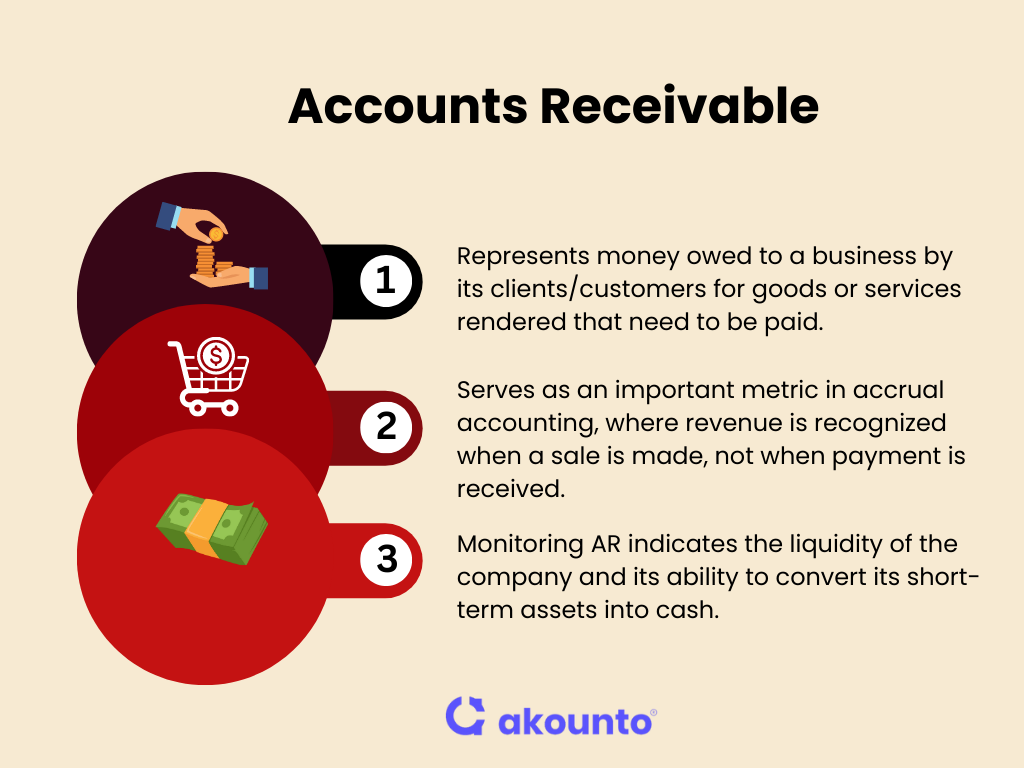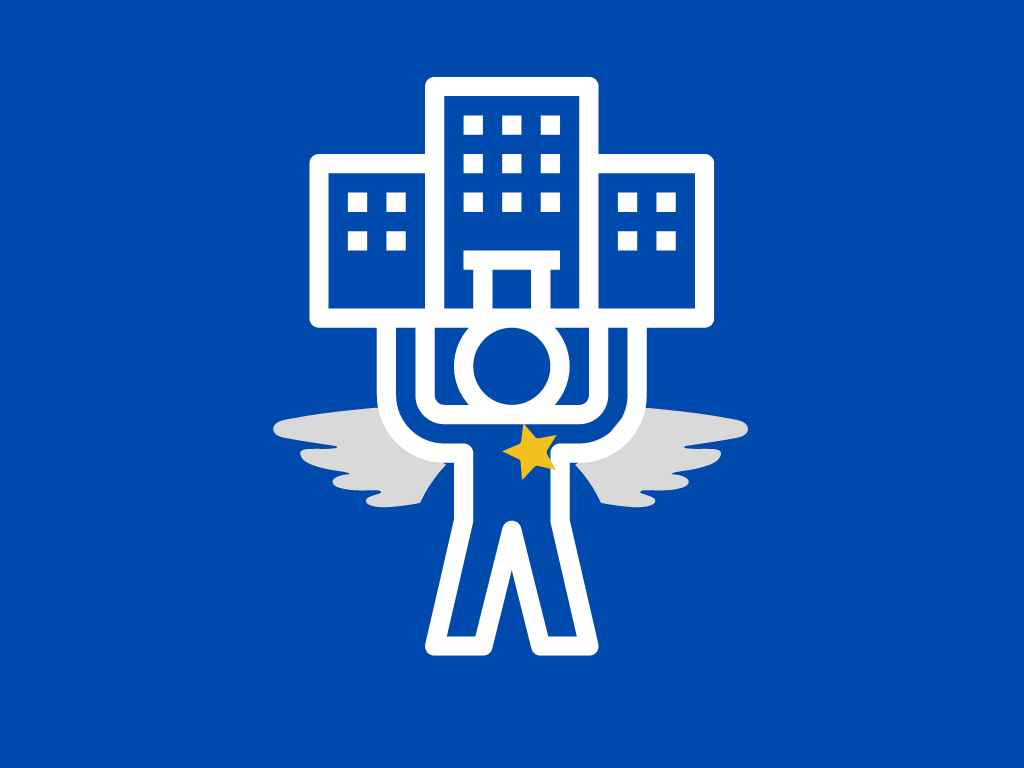What is Accounts Receivable?
Accounts receivable (AR) are assets representing money owed to a business by customers for the goods and services taken but not yet paid. Accounts receivable are created due to sales on credit.
What’s covered in the article
Accounts receivable represents the right to receive payments for the goods sold or the services given. From the customer side, it is the obligation to pay. The “right to receive” money makes accounts receivable as an asset.
Like all assets and liabilities, accounts receivables are shown on the asset side of the company’s balance sheet. Under assets, accounts receivable are classified as “liquid assets” as they have the possibility to be converted to cash within a year. Also, the company can mortgage accounts receivable for taking further loans, just a form of debt securitization.
Accounts receivable are also current assets due to cash-convertibility within a short period. But there is also an underlying risk to accounts receivables, that in case the customer does not pay, then it can lead to bad debt.
Businesses resort to credit sales for the following reasons:
- to do more sales, leading to a larger market share
- to clear stock/ inventory
- to promote customer loyalty
- to give offers in seasonal sales like fall/ summer or Black Friday Sale
- Market expansion
- to gain a competitive edge
- to gain new customers
Being a current asset accounts receivables directly impact the liquidity of the company. Even in the formula of the current ratio, you use accounts receivables as one of the components of current assets.
Monitoring accounts receivable becomes important for the company as there is an underlying risk of payment delays or even a bad debt. There is no surety that all the unpaid invoices will be paid, so using accounts receivable to calculate the liquidity position of a company is a little risky.

Is accounts receivable an asset or liability?
Accounts receivables are “current assets” and “liquid assets.” They are entered as a line item under current assets in the balance sheet of the company. Accounts receivable is not a liability; it represents money owed to the company, not money the company owes.
Assets are resources owned by a company that hold monetary value and are classified into two main categories: fixed and current assets. Fixed assets, like machinery or real estate, are not easily converted into cash. Current assets, like cash equivalents and notes receivable, are expected to be converted to cash within a reporting period, typically a year.
Assets can be tangible or intangible. Tangible assets have a physical presence, like buildings or equipment, while intangible assets, such as patents, goodwill, or copyrights, lack a physical form but hold significant value for a company.
Accounts receivable is a current asset because it is expected to be converted to cash within the working capital cycle, typically within payment terms agreed upon with clients. The receivable balance signifies the monetary value of goods or services that are already delivered and awaiting payment.
Given its nature, accounts receivable directly impact a company’s cash flow and are integral to its operational efficiency. In accrual basis accounting, even if the cash hasn’t been received, the company’s AR indicates expected future inflows, solidifying its position as an asset.
Accounts Receivable and Financial Statements
Balance Sheet
The balance sheet presents the company’s financial position at a specific point in time. It lists assets, liabilities, and shareholders’ equity.
As a current asset, accounts receivable prominently feature on the balance sheet, representing the money customers owe the business for goods (or services) already delivered. The accounts receivable balance clearly indicates the cash inflows a company expects shortly.
As a current asset, accounts receivable are expected to be converted to cash within a year, making it a liquid asset that bolsters the company’s short-term financial strength. Unlike physical and tangible assets, accounts receivable is an intangible representation of future cash flows.
Income Statement
Accrual accounting recognizes revenue when a sale is made, not necessarily when the cash is received. If a customer hasn’t paid yet, the sale is recorded. When the customer pays, it reduces the accounts receivable balance and increases the cash balance, ensuring the income statement and balance sheet remain interconnected.
When the credit sale was made, the revenue was reflected in the income statement of that reporting period, while the “right to receive” money in the form of accounts receivable was entered in the balance sheet as a current asset.
Accounts Receivable and Doubtful Accounts
Accounts receivable represent the money clients owe a company; not all receivables may be collected. This is where the concept of doubtful accounts comes into play.
Doubtful accounts (bad debt) represent the portion of accounts receivable that a company believes may not be collectible. This could be due to various reasons, such as a client’s bankruptcy, disputes over the product or service quality, or other financial challenges the client faces.
Recognizing doubtful accounts is crucial for businesses to provide a realistic view of their expected revenue.
On the balance sheet, accounts receivable are typically shown as their gross amount, with an allowance for doubtful accounts subtracted to reflect the net amount expected to be collected. Doubtful debt allowance is an estimate based on historical data, industry standards, and the company’s knowledge of its clients.
When accounts are uncollectible, they are written off as bad debt expenses, impacting the income statement. This ensures that reported revenue aligns with the actual cash the company expects to receive. It’s essential to regularly review and adjust the allowance for doubtful accounts to ensure the balance sheet accurately represents the company’s financial position.
While accounts receivable revenue indicates potential inflows, the presence of unpaid receivables and bad debt highlights the uncertainties in business operations. By addressing doubtful accounts, companies can offer a true and accurate picture of the financial health and the actual revenue they can anticipate.
Examples
Example 1
Company A provides consulting services to Company B. After completing the services; Company A sends an invoice of $10,000 to Company B, which agrees to pay within 30 days. How should Company A record this transaction, and what happens when the payment is received?
Solution
Company A should record the $10,000 as accounts receivable on its balance sheet, indicating the amount Company B owes. Once Company B makes the cash payment, Company A will decrease its accounts receivable by $10,000 and increase its cash balance by the same amount.
Example 2
Company A sells products worth $15,000 to Company B on credit with payment terms of 60 days. However, Company B can only pay $5,000 within the stipulated period due to financial constraints. How should Company A account for this transaction?
Solution
Initially, Company A will record the full invoice amount of $15,000 as accounts receivable. Upon receiving the partial cash payment of $5,000 from Company B, Company A will reduce its accounts receivable by the full invoice amount but will recognize a bad debt of $10,000 to account for the unpaid balance.
Using Automation Software
Managing accounts receivable manually can be cumbersome and prone to errors. It is advisable to use receivable automation software. This advanced tool streamlines the process of tracking invoices, payments, and outstanding balances.
By automating these tasks, businesses can ensure accuracy, reduce the time spent on manual entry, and enhance their cash flow management. Moreover, with real-time updates and analytics, receivable automation software provides valuable insights into customer payment behaviors, helping businesses make informed decisions.
Embracing such technology from Akounto optimizes operations and positions a company at the forefront of financial innovation.
Conclusion
Accounts receivable is a crucial financial metric indicating the money owed to a company for services or goods delivered. While it’s an asset, not all receivables are guaranteed, necessitating provisions for doubtful accounts. Automation software can streamline AR management, ensuring accuracy and offering insights into payment behaviors. Proper understanding and management of accounts receivable are vital for a company’s financial health and operational efficiency.











